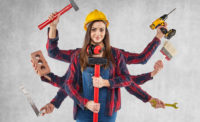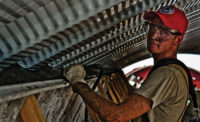New ANSI standard covers MEWP design, training & safe use
Improving mobile elevated work

Mobile elevated work platforms (MEWPs), such as boom and scissor lifts, are powerful, durable and useful machines that help workers perform a wide range of tasks at height. Training operators and other workers on the safe use of these machines is crucial to decrease the risk of injuries, property damage and liability on the worksite.
As equipment in the access industry continues to evolve, so too must the safety standards the industry relies upon. It’s imperative for machine owners and operators to understand these safety standards, stay abreast of any upcoming modifications and prepare themselves accordingly. The new ANSI A92 standard for the access and lift equipment industry addresses new issues, simplifies the MEWP classification terminology and promotes safety and education.
The ANSI A92 standard
ANSI, the American National Standards Institute, is a private, nonprofit organization that develops consensus standards and assessment systems across many U.S. industries. While they apply specifically to products in the United States, these standards are used as guidelines and best practices around the world.
With the last major changes to ANSI standards in the access industry taking place more than a decade ago in 2006, it was time for an update. The new ANSI A92 standard was developed to improve safety and efficiency for the design and use of MEWPs, formerly known as aerial work platforms. The updated ANSI A92 suite of design, safe use and training standards was published in the U.S. on Dec. 10, 2018 and will be officially effective in December 2019. These new standards more closely align North American standards requirements with current ISO standards.
Effects on manufacturers, owners and operators
Within ANSI A92, there are three standards affecting the MEWP industry and its stakeholders—the A92.20, covering design; the A92.22, covering safe use; and the A92.24, covering training. Notably, manufacturers must address design changes that impact MEWP wind ratings, chassis angle and load capacity.
Under these new standards, MEWPs are classified differently. MEWPs are divided into Group A for those with platforms that move vertically but stay inside the tipping line, and Group B for all other MEWPs – typically, boom-type equipment where the platform extends past the tipping line.
Within each of these groups, machines are separated into types: Type 1 for those that travel only in the stowed position, Type 2 for those that can travel while elevated but controlled from the chassis, and Type 3 for those that can travel while elevated but controlled from the work platform.
When it comes to safe use and training, machine owners and operators will have their own sets of responsibilities with which to comply. Dealers and rental companies will need to update their training procedures and onboarding manuals to support new requirements and train employees on new machine features and the new standards. They must also offer familiarization to customers who rent, lease or buy this equipment.
Owners and operators must meet all new training requirements, participate in extensive planning to consider machine choice and application, and perform site risk assessments for all MEWP operations and training procedures.
Anyone qualified under current standards will not be qualified under the new standards until they undergo additional training. While current regulations require all operators in the industry to go through safety training, the new standards will require everyone who supervises MEWP operators to also be trained and possess in-depth knowledge of the equipment. Examples of the knowledge required by occupants includes being well-informed about hazards associated with MEWPs, unsafe ground conditions or electrical hazards, and how to properly lower the machine in case something happens to the operator.
Operator training can be broken down into three segments: theory, practice and evaluation. The theory segment can be learned in a classroom or online and includes training on the entire safe-use standard and its application to each machine. The practice segment includes applying this knowledge for proper hands-on experience and machine operation. The evaluation segment includes proper documentation of success in the previous two training segments.
The time is now
ANSI A92 standards were published a year in advance of the December 2019 effective date, giving companies a year to become compliant. Many companies have already begun to implement these changes. However, many have not even started.
From a training and safe-use perspective, there is no reason to wait until that deadline gets closer. Everyone involved with MEWPs – no matter the industry – should start implementing the safe use policies and practices right now.
Looking for a reprint of this article?
From high-res PDFs to custom plaques, order your copy today!







